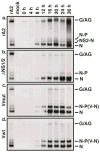Replacement of the respiratory syncytial virus nonstructural proteins NS1 and NS2 by the V protein of parainfluenza virus 5
- PMID: 17632199
- PMCID: PMC2078599
- DOI: 10.1016/j.virol.2007.06.017
Replacement of the respiratory syncytial virus nonstructural proteins NS1 and NS2 by the V protein of parainfluenza virus 5
Abstract
Paramyxoviruses have been shown to produce proteins that inhibit interferon production and signaling. For human respiratory syncytial virus (RSV), the nonstructural NS1 and NS2 proteins have been shown to have interferon antagonist activity through an unknown mechanism. To understand further the functions of NS1 and NS2, we generated recombinant RSV in which both NS1 and NS2 were replaced by the PIV5 V protein, which has well-characterized IFN antagonist activities (DeltaNS1/2-V). Expression of V was able to partially inhibit IFN responses in DeltaNS1/2-V-infected cells. In addition, the replication kinetics of DeltaNS1/2-V were intermediate between DeltaNS1/2 and wild-type (rA2) in A549 cells. However, expression of V did not affect the ability of DeltaNS1/2-V to activate IRF3 nuclear translocation and IFNbeta transcription. These data indicate that V was able to replace some of the IFN inhibitory functions of the RSV NS1 and NS2 proteins, but also that NS1 and NS2 have functions in viral replication beyond IFN antagonism.
Figures







References
Publication types
MeSH terms
Substances
Grants and funding
LinkOut - more resources
Full Text Sources
Other Literature Sources

